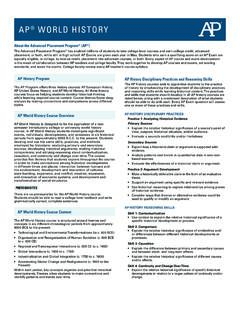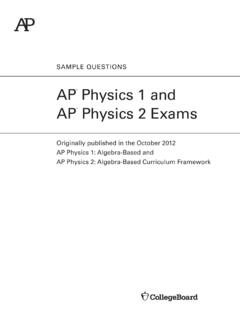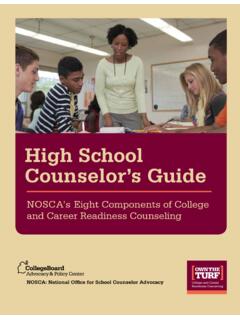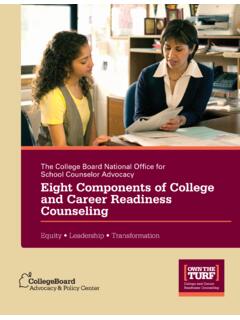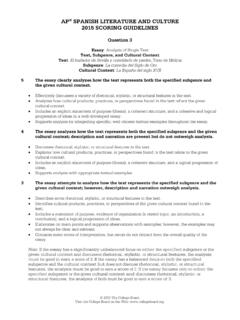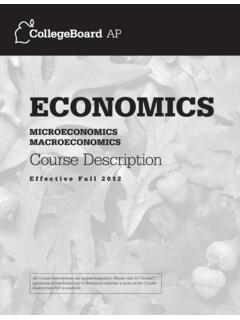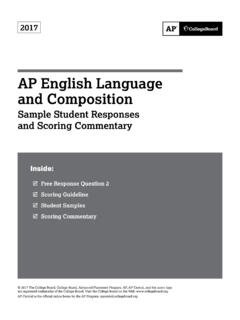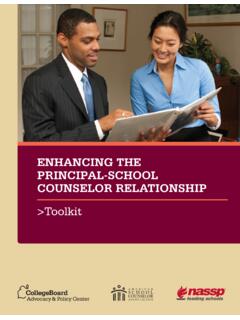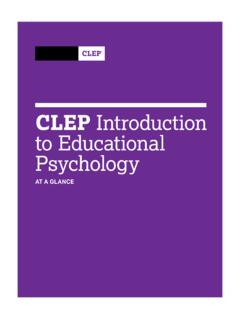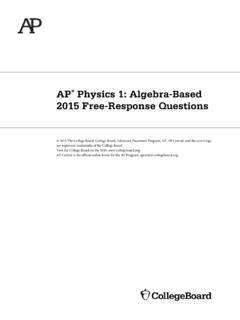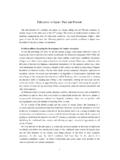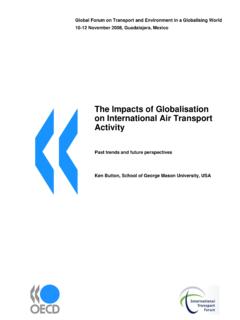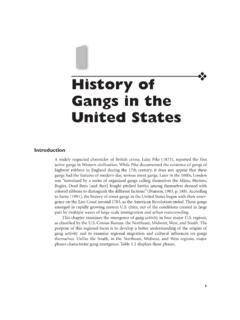Transcription of AP World History - College Board
1 2018AP World HistorySample Student Responses and Scoring Commentary 2018 The College Board . College Board , Advanced Placement Program, AP, AP Central, and the acorn logo are registered trademarks of the College Board . Visit the College Board on the Web: Central is the official online home for the AP Program: : Document-Based Question RScoring Guideline RStudent Samples RScoring Commentary AP World History 2018 SCORING GUIDELINES 2018 The College Board Visit the College Board on the Web: Question 1 Document-Based Question Maximum Possible Points: 7 Evaluate the extent to which railroads affected the process of empire-building in Afro-Eurasia between 1860 and 1918. Points Rubric Notes A: Thesis/Claim (0-1) Responds to the prompt with a historically defensible thesis/claim that establishes a line of reasoning. (1 point) To earn this point the thesis must make a claim that responds to the prompt rather than restating or rephrasing the prompt.
2 The thesis must consist of one or more sentences located in one place, either in the introduction or the conclusion. The thesis must take a position on the extent to which railroads affected the process of empire-building in Afro-Eurasia between 1860 and 1918 and indicate some reason for taking that position. Examples: Although railroad construction in Asia and Africa greatly facilitated the development of European colonial empires, it also aided in the emergence of nationalist movements against European rule. (Responds to the prompt with an evaluative claim that establishes a line of reasoning) The construction of railroads in Afro-Eurasia helped European imperialism because it allowed Europeans to increase their political power in Asia and Africa. (Responds to the prompt with a minimally acceptable claim that establishes a line of reasoning) B: Contextualization (0-1) Describes a broader historical context relevant to the prompt.
3 (1 point) To earn this point the response must relate the topic of the prompt to broader historical events, developments, or processes that occur before, during, or continue after the time frame of the question. This point is not awarded for merely a phrase or reference. To earn the point the response must accurately describe a context relevant to the role of railroads in the process of empire-building in Afro-Eurasia in the nineteenth and twentieth centuries. Examples: Railroads played an important role in the Industrial revolution because they provided a faster and more efficient method of overland transport than had ever existed before. (relates broader events and developments to the topic) Industrial revolution technologies aided Europeans in the creation of large empires by linking places together at cheaper cost. (relates broader events and developments to the topic) AP World History 2018 SCORING GUIDELINES 2018 The College Board Visit the College Board on the Web: Question 1 Document-Based Question (continued) C: Evidence (0-3) Evidence from the Documents: Uses the content of at least three documents to address the topic of the prompt.
4 (1 point) OR Supports an argument in response to the prompt using at least six documents. (2 points) To earn 1 point the response must accurately describe rather than simply quote the content from at least three of the documents to address the topic of railroads and imperialism in Afro-Eurasia in the nineteenth and early twentieth centuries. Example: (Document 1) In its petition to the British colonial government, the British-Indian Association complains that Europeans in second-class carriages treat them poorly. (Describes the document accurately, and thus is credited as addressing the topic, but does not explicitly tie the description to an argument in response to the prompt) OR To earn 2 points the response must accurately describe rather than simply quote the content from at least six documents. In addition, the response must use the content from the documents to support an argument in response to the prompt.
5 Example: (Document 5): The editorial to the News Chronicle in 1901 arguing for Britain and other European powers to protect their interests in Asia against the future Russian expansion that would follow the construction of the Trans-Siberian Railroad illustrates that railroads facilitated the expansion of empires. (Accurately describes and connects the content of the document to an argument about the effects of railroads on empire-building in Afro-Eurasia) AP World History 2018 SCORING GUIDELINES 2018 The College Board Visit the College Board on the Web: Question 1 Document-Based Question (continued) Evidence beyond the Documents: Uses at least one additional piece of specific historical evidence (beyond that found in the documents) relevant to an argument about the prompt. (1 point) To earn this point the evidence must be described, and it must be more than a phrase or reference. This additional piece of evidence must be different from the evidence used to earn the point for contextualization.
6 Statements credited as evidence from outside the documents will typically be more specific details relevant to an argument, analogous to the function of evidence drawn from the documents. Typically, statements credited as contextualization will be more general statements that place an argument or a significant portion of it on a broader context. Example: Like the European powers, Japan developed an extensive railway network in Korea to facilitate its imperial control. (P rovides a piece of evidence not in the documents relevant to an argument that addresses the prompt) D: Analysis and Reasoning (0-2) Sourcing: For at least three documents, explains how or why the document s point of view, purpose, historical situation, and/or audience is relevant to an argument. (1 point) See document summaries for examples of possible sourcing. To earn this point the response must explain rather than simply identify how or why the document s point of view, purpose, historical situation, or audience is relevant to an argument that addresses the prompt for each of the three documents sourced.
7 Examples: (Document 3): Because the Ottoman sultan had to approve the proposals mentioned in Document 3, the report attempts to flatter the sultan by emphasizing his supposed popularity among Muslims across the World and how the construction of a railroad from Damascus to Mecca would only increase that popularity. (Provides sourcing regarding the audience of the government report relevant to an argument addressing the prompt) (Document 5): As a politician, Sir Henry Norman is critical of Britain continuing to sleep in terms of responding to Russian imperial expansion in East Asia, and he is interested in persuading the British government and public opinion to adopt a different policy. (Provides sourcing regarding the POV of the author relevant to an argument addressing the prompt) AP World History 2018 SCORING GUIDELINES 2018 The College Board Visit the College Board on the Web: Question 1 Document-Based Question (continued) Complexity: Demonstrates a complex understanding of the historical development that is the focus of prompt, using evidence to corroborate, qualify, or modify an argument that addresses the question.
8 (1 point) This understanding must be part of the argument, not merely a phrase or reference. Examples of demonstrating a complex understanding for this question might include: Considering the totality of the evidence and perspectives presented in the documents as demonstrated by creating a complex argument, while at the same time recognizing that some documents corroborate, qualify or modify the overall argument Explaining the nuance of an issue by analyzing multiple factors or by considering diverse or alternative perspectives or evidence, such as constructing an argument that explains how European railroad construction simultaneously strengthened colonial authority in Africa and Asia while also contributing to growing tensions with indigenous communities and eventually leading to the development of nationalist movements Explaining relevant and insightful connections across time and space, such as explaining how r ailroads and other new types of communication were used to strengthen nation states in the nineteenth century ( , European states, United States, Meiji Japan)
9 Or in premodern times ( , the Roman road networks or the Mongol postal system.) If response is completely blank, enter - - for all four score categories A, B, C, and D. AP World History 2018 SCORING GUIDELINES 2018 The College Board Visit the College Board on the Web: Question 1 Document-Based Question (continued) Document Summaries and Possible Sourcing Document Summary of Content Explains the relevance of point of view, purpose, situation, and/or audience by elaborating on examples such as: 1. British-Indian Association petition to the British colonial government (1866) Claims that high-caste Hindus are subject to abuse from European passengers on second-class carriages and are forced to interact with the masses outside the train platforms. Women s respectability is also jeopardized. Imposition of direct British rule following the Indian Rebellion of 1857. (situation) High-caste Hindus complaining about the lack of traditional deference shown to them because of their social status.
10 (POV) Since the purpose is to get the government to act, the petition uses hyperbole (the analogy to the Middle Passage). 2. Qing dynasty official memorandum to the court (1867) Argues that the Qing government should build railroads but should not do so by giving concessions to Western companies, unless they meet very stringent criteria. Memorial written in the context of the Self-Strengthening movement and following the Taiping Rebellion. (situation) The official wants to modernize China without antagonizing the rural population. (purpose) May infer that the official advocates setting a very high bar for giving Westerners permission to build railways because he is in favor of the chinese building the railways. (purpose) 3. Ottoman government report (1893) Argues that the construction of a railroad from Damascus to Mecca would aid Muslims in traveling to the holy cities of Mecca and Medina and would increase the prestige of the Ottoman sultan in the Muslim World .
